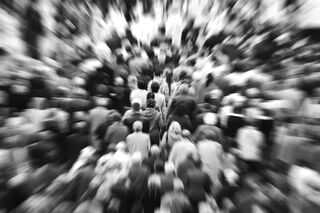Guilt
Avoiding the Pitfalls of "Collective Guilt"
United we stand, divided we fall.
Posted September 7, 2021 Reviewed by Ekua Hagan
Key points
- Diversity is only a strength if it is accompanied by synergy.
- Synergy is achieved through collaboration, and every interaction is an opportunity to strengthen or weaken connections with others.
- The projection of guilt by association creates barriers to connecting meaningfully with others.
- Moving past the pitfalls of collective guilt requires forgiveness, or letting go of one's suffering.

We are living in a very unsettled and troubled time, one that appears to be marked more by division than unity. Good intentions notwithstanding, it is becoming increasingly apparent that polarizing notions like “identity politics,” “cancel culture,” “political correctness,” and so forth have not been helpful in finding common ground. Rather than seeking to bridge the ever-widening divide between people holding different points of view, these highly charged, provocative labels primarily serve to focus attention on what separates people as opposed to what connects them.
Today the often-heard expression “diversity, equity, and inclusion” seems to have achieved the status of a ubiquitous workplace mantra. With good intentions, this memorable phrase is being used by leaders to advance organizational and even societal transformation. However, such efforts at systemic reform are doomed to fall short of their well-meaning target if they inadvertently sow the seeds of division and discord among people rather than engage all stakeholders in authentic dialogue and collaborative action.
If we don’t emphasize what connects us, we will be divided.1
The late Dr. Stephen R. Covey, author of the bestseller, The 7 Habits of Highly Effective People, and the foreword to our book, Prisoners of Our Thoughts, espoused the notion that “diversity is the beginning of synergy.” But diversity alone is not sufficient for synergy to occur. By definition, synergy requires interaction or collaboration; it comes from the Greek word synergos (συνεργός), meaning “working together.” Therefore, no matter how “diverse” the members of a group may be, synergy can only begin if there is an awareness of interdependency and the spirit of cooperation among them. Importantly, in order to be activated and sustained, synergy needs some kind of united effort in which there is mutual benefit for the stakeholders involved.2
It is extremely important, especially in today’s highly polarized world, to minimize barriers to inclusion in order to both increase diversity of all kinds, including diversity of thought, and facilitate synergy by leveraging the power of meaningful engagement among stakeholders through the process of authentic dialogue, group problem-solving, and other means of collaboration.
The barrier of collective guilt
I’d like to address one of the barriers to advancing diversity and synergy that seems to be either ignored or misunderstood. I’m referring to something called “collective guilt,” which essentially is “guilt by association.”3 Put differently, it is the belief that members of a group are in some way responsible for the actions of other members of the same group, even though they were not directly involved in committing such actions.
The Swiss psychoanalyst Carl Jung wrote an essay in 1945 in which he introduced the term collective guilt, describing it as a psychological phenomenon.4 Holding all Germans, by association, responsible for the atrocities committed by the Nazis during World War II is a prime example of collective guilt.5 The German-Swiss psychiatrist and philosopher Karl Jaspers believed that collective guilt applied both to those Germans who committed atrocities and those who tolerated them without resistance.6
But not everyone subscribes to the concept of collective guilt, especially when blame is extended collectively over multiple generations of people who, due solely to their group identity or membership, are lumped together and presumed guilty by association.
The world-renowned psychiatrist and Holocaust survivor Viktor E. Frankl vigorously opposed the notion of collective guilt of Germans shortly after being liberated from the Nazi concentration camps.7 He realized that blaming all Germans or labeling all of them as “Nazis” would only consume his life with bitterness and hatred. Although he did not forget his past, Frankl learned from his horrific experiences that blaming the collective does not heal. Instead, as part of his life legacy, he discovered a way to find meaning in suffering and was able to forgive those who had tried to destroy him. In his own words:
“As for the concept of collective guilt, I personally think that it is totally unjustified to hold one person responsible for the behavior of another person or a collective of persons.”8
The manifestation of collective guilt occurs in two ways: (1) as self-imposed by members of the particular group deemed guilty; and (2) as a projection on others who are profiled, be it by nationality, race, ethnicity, age, gender, political affiliation, etc., and therefore identified as members of the group deemed guilty. These forms of collective guilt need to be avoided if authentic connection, reconciliation, healing, and meaningful, systemic reform can be achieved.
Principles to help us avoid the pitfalls of collective guilt
Our book, Prisoners of Our Thoughts, which is based on the wisdom of Viktor Frankl, describes and applies the core principles of logotherapy and existential analysis in life, work, and society.9 Importantly, these meaning-centric principles, among other things, provide practical guidance on how to avoid the pitfalls of collective guilt, both self-imposed and projected on others.
The first principle pertains to the “ultimate freedom” to choose our attitude in all situations. Although we may not be in control of the conditions or situations that confront us, we can choose how we respond to them through our choice of attitude. Our choice of attitude will largely determine the degree to which we will be able to find meaning in our suffering, connect meaningfully with others, and extend beyond ourselves to move toward forgiveness.
Forgiveness means letting go of our suffering. It has much more to do with our own well-being than with that of the person(s) we forgive. When we hold on to our suffering—our resentment, hurt, blame, anger—we are inside ourselves with self-pity even if we try to project individual or collective guilt on others. Our suffering becomes a veil through which we see ourselves and others.
Forgiveness does not mean forgetting, diminishing, or condoning the misdeed. It has more to do with freeing ourselves from its hold. As part of our healing process and search for meaning, we must be able to escape not only our inner mental prison but also release those who may be held guilty in the prison of our thoughts solely because of their group identity or membership.
References
1. Alex Pattakos and Elaine Dundon (2015). The OPA! Way: Finding Joy & Meaning in Everyday Life & Work. Dallas: BenBella Books, p. 41.
2. This assertion is based on the author’s longstanding empirical research and field experience, much of which has been published in the professional, peer-reviewed literatures in political science, psychology, and systems science, exploring the determinants of interpersonal, interorganizational, and intergovernmental relations and collaboration.
3. For a broad-based examination of the nature of collective guilt, see: Nyla R. Branscombe and Bertjan Doosje, eds., Collective Guilt: International Perspectives, Cambridge University Press, 2004. For an elaboration of the antecedents of collective guilt, see: Mark A. Ferguson and Nyla R. Branscombe (2014). “The social psychology of collective guilt,”, in Christian von Scheve and Mikko Salmela (eds.), Collective Emotions: Perspectives from Psychology, Philosophy, and Sociology, Oxford University Press, Chapter 17, pp. 251-265. For evidence of the neurological basis of collective guilt, see: Zhiai Li, et al. (2020). “Guilty by association: How group-based (collective) guilt arises in the brain,” NeuroImage, 209 116488: https://doi.org/10.1016/j.neuroimage.2019.116488
4. Carl G. Jung (1945). “After the Catastrophe,” reprinted in Gerhard Adler and R.F.C. Hull (eds.), The Collected Works of C.G. Jung, Volume 10: Civilization in Transition, 2nd Ed., Princeton University Press, 1970, pp. 194-217. [First published as “Nach der Katastrophe,” Neue Schweizer Rundschau (Zurich), n.a., XIII (1945). pp. 67—88.]
5. Similarly, holding all Muslims, by association, responsible for the coordinated terrorist attacks on September 11, 2001, often referred to as “9/11,” is yet another example of collective guilt.
6. Karl Jaspers (2001). The Question of German Guilt. New York: Fordham University Press. Originally published as Die Schuldfrage, München, Germany: Piper Verlag GmbH, 1947.
7. Viktor E. Frankl (1997). Viktor Frankl Recollections: An Autobiography, trans. Joseph and Judith Fabry, New York: Plenum Press, p. 103.
8. Viktor E. Frankl, Man's Search for Meaning: An Introduction to Logotherapy, 4th edition, Boston: Beacon Press, p. 150.
9. Alex Pattakos and Elaine Dundon (2017). Prisoners of Our Thoughts: Viktor Frankl’s Principles for Discovering Meaning in Life and Work, 3rd edition. Oakland: Berrett-Koehler Publishers.




